Past projects
We are interested in molecular regulation of cardiovascular, metabolic and kidney diseases. Particular focuses are on chronic inflammation.. We are also actively studying transcriptional and epigenetic control of macrophages and smooth muscle cells.
1. KLF5 in cardiometabolic disease.
Members of the Krüppel-like factor (KLF) family of transcription factors are important regulators of development, cellular differentiation and growth, and pathogenesis of atherosclerosis and in tumor development. We identified KLF5 as a positive regulator of SMemb, a marker gene for activated smooth muscle cells in vascular disease (Circ Res 85:182-191, 1999). The pattern of expression of KLF5 is very similar to that of SMemb; i.e., it is abundantly expressed in embryonic vascular SMCs, is undetectable in mature cells, and is re expressed in phenotypically modulated cells present in neointimal lesions in rats and in atherosclerotic lesions in human coronary arteries.
Recently, we generated a strain of KLF5 knockout mice (Nat. Med). Homozygous null mutation of KLF5 is lethal at a very early stage of embryonic development, which is indicative of the essential role it plays at that stage. On the other hand, heterozygous (KLF5+/-) mice exhibit only subtle mutation-related phenotypes, including a relatively thin media of the aorta. It is only after injury to the cardiovascular system that expression of clear KLF5+/- related phenotypes becomes apparent. Following vascular injury, neointima and granulation tissue formation, adventitial reactivity, and angiogenesis are all substantially diminished in KLF5+/- mice as compared to wild-type mice (Fig. 1). Interestingly, KLF5 is also expressed in myofibroblasts in the adventitia and myocardium, and Ang II loading induces much less cardiac fibrosis and hypertrophy in KLF5+/- mice than in wild-type mice. These data demonstrate that KLF5 plays an essential role in mediating cardiovascular remodeling.
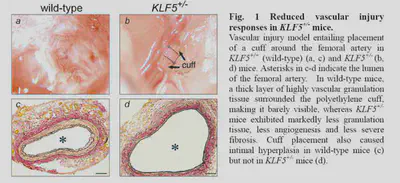

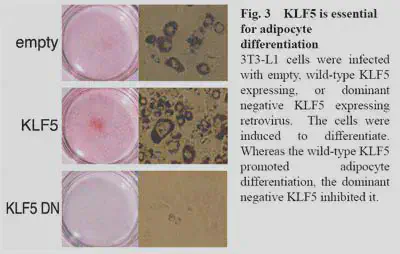
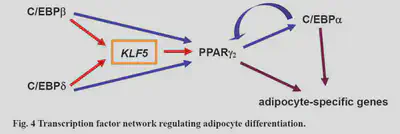
We recently found that KLF5 heterozygous knockout mice are resistant to high fat diet-induced metabolic syndrome. Our study clearly demonstrated that SUMOylation of KLF5 acts as a molecular switch to control lipid metabolism (Nat Med). Our studies strongly suggest that KLF5 plays multiple roles in development of both metabolic syndrome and its clinically important consequences, including atherosclerotic cardiovascular disease.
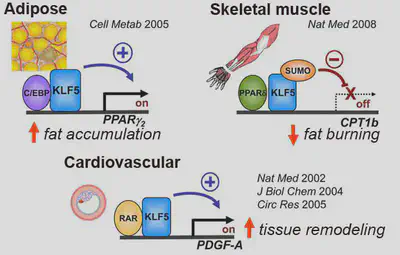
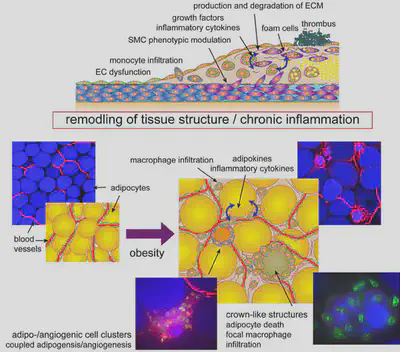
We then showed that adipose tissue inflammation is regulated by complex interplay betwen pro-inflammatory and anti-inflammatory cells. We reported CD8+ T cells promote inflammation, while adipose tissue natural regulatory B cells suppress it (Nat Med, Cell Metab).
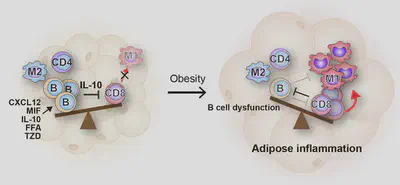
In addition to adipose tissue, we have been studying inflammatory mechanisms in othe tissues, such as heart, pancreatic islets and kidneys. For instance, we showed that islet inflammation is pivotally involved in the development of beta cell dysfunction in type 2 diabetes (Cell Metab).
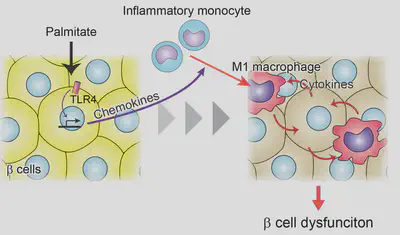
We are interested in the divergent functions/phenotypes of macropahges in tissues. We reported differential functions of macrophages in the course of responses to renal injury (J Clin Invest). We are analysing functions of other tissue macropahges using in vivo models and vairous technologies, including NGS. We are also studying long noncoding RNAs in macrophages.
Another focus of our research is to elucidate transcriptional and epigenetic mechanisms that control smooth muscle cell differentiation (Dev Cell). We also reported smooth muscle cell phenotypic modulation in lymphedema (Br J Dermatol).
We have been developing novel therapeutic strategies based on the findings of transcription factor networks. For instance, we have found an antagosit against KLF5 (Circ Res, Arterioscler Thromb Vasc Biol). We used a new metal for coronary stents (Sci Technol Adv Mater). We also developed nanoparticle-mediated siRNA therapeutics (Cancer Res).